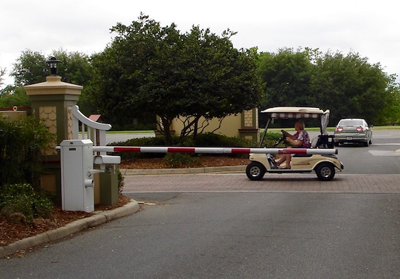More Neighbors Likely and New Types of PTVs
[Note, my company, Small Vehicle Resource, has just published a major market research report on the market for small, task-oriented vehicles—golf cars, PTVs, light duty utility vehicles, and off-road UTVs—with an outlook to 2025 incorporating the newly emerging opportunities for growth in the urban/suburban mobility (USM) market. If this is of interest, you can contact me at smetzger@smallvehicleresource.com .]
It is highly likely that our orderly and enjoyable life in our gated communities will become more and more attractive to city dwellers in these times given worries about COVID-19 and future pandemics. On top of that, throw in the new trend in the delightful urban pastime of rioting and looting, and you have what appears to be a stampede to leave cities. This, especially seen in the big, one party-ruled urban centers, such as Chicago, New York, and San Francisco. (Of course I am being very discrete in not mentioning the one party.)
In the wake of what will probably be, as a result, a long term trend in a “dispersed living lifestyle”, it is also very likely that we will also see new types of PTVs. (I hope most of us know what the acronym PTV means. “Golf cart” is so…yesterday!)
In this column I take on these two themes—urban exodus and PTV transformations. Weighty subjects but compelling evidence as to what is happening
A marginalized urban environment: Dreaded attack of CCP—Contagion, Congestion, and Pollution
Urban centers were to their inhabitants such benefits as a rich and diverse cultural environment, the synergy of close contact with fellow professionals, and readily available public services attending to the somewhat grubby necessities of life, such as garbage pickup and law enforcement. Instead, the reality in these current times is that cities have become the focal point of contagion, congestion, and pollution (CCP)—not to speak of an exorbitant cost of living.
These highly objectionable components of city dwelling are now compounded by daily political demonstrations, very often involving rioting, looting, physical injury to humans, and even lethality. In an oxymoronic response, big city governments have defunded police departments rendering a state of peaceful existence virtually impossible.
Is it any wonder that there is a pronounced exodus to the suburbs and beyond? For us in our gated communities, the bright spot is likely to be a significant increase in real estate values, as we welcome our new neighbors.
For those of us now ensconced in our gated communities the bright spot in the urban exodus could be a significant increase in the value of our real estate investment. (Who knew?)
San Francisco’s Golden Gate now the Exodus Gate
As a specific example, of urban emigration, in an article published on the website, “Affluent Investor” cited trends in San Francisco. The articles author, Jerry Bowyer, states, “…people, especially wealthy people, seem to be rushing out of the city.” He references and quotes a local newspaper story reporting the trends in real estate in the distant exurbs of San Francisco in comparison with the central metro area:

“Amid the depths of a global pandemic and financial downturn, the demand for real estate is unexpectedly rocketing in wealthy regions outside San Francisco, reports Bloomberg. Agents say that demand is soaring in affluent areas around the Bay Area such as Napa, Marin and further afield in Carmel, as people who have the means look to get away from the city. Meanwhile, the market in San Francisco and Alameda County is still well below where it was last year.”
Of course, the wealthy are the most mobile in society, so they are making the first move, but this is only Phase I of what is likely to become an urban diaspora involving a much broader segment of the economic spectrum. What is likely to occur over time, albeit hardly in the distant future, is the emergence of residential developments, much like our gated communities, that offer clustered housing, self-contained and of limited size—and at the same time geographically dispersed. Appropriately planned, such developments would include schools, entertainment centers, and retail outlets. Such communities would require small electric vehicles for internal mobility and a readily available charging station network.
Such developments are all the more feasible, thanks to COVID-19, because of work from home, virtual office systems that significantly mitigate the need to gather collectively in urban centers—or, for that matter, corporate campuses.
What will mobility look like in the world of a dispersed living lifestyle?
PTVs, even the very popular Club Car Onward clearly show their golf car roots. They are open-air conveyances, and although decked out with a growing number of conventional automobile features, such as Bluetooth, dashboards with LCD touch panels, LED lighting, etc., are still largely a fair weather conveyance. (Yes, even in mild climates it does rain sometimes.) Flexible fabric enclosures are, of course, available but are not very convenient and lack much in the way of style and looks.
To address more broadly what we at Small Vehicle Resource call the urban/suburban mobility (USM) market, there are likely to be many modifications to current PTVs and . New designs will be influenced by new mobility systems already widely in use in various metropolitan areas across the country, namely e-bikes and scooters. The influence, per se, is a contagious (the good kind) awakening to a new variety of conveyances getting you from point A to point B.
Filling the gap between ride-share scooters and mopeds and convention vehicles
There is a big gap, however, between two-wheeled mobility and the conventional automobile or truck. A start-up in Sweden may have found the middle ground in the Zbee, manufactured by the Clean Motion company. As you can see from the photo below, it is a battery-powered three-wheeler, fully enclosed and weatherized. It comes in a passenger version for three people or a cargo version for a driver and space accommodating approximately 400 pounds of cargo.

The Zbee is featured in this article, not because of its commercial viability, that is, its progress in the market—of which I have no idea at this point—but rather because of its type of design, which would fit perfectly in the setting of a gated community and the emerging dispersed living lifestyle.
It is not only spiffy in its looks, but has a number of engineering features which set it apart from today’s PTV. In particular, the vehicle has hydraulic disk brakes on all three wheels and in-hub electric motors in the two rear wheels.
It has relatively fast plug-in recharging of its lithium batteries of 4.5 hours and really fast charging via an external charger. Another excellent feature is an optional system of swappable batteries, which greatly extend distance and run time over an above the vehicle’s standard 50 mile range.
Will the Zbee or its emulators be the new look in gated communities? Quite possible in my opinion. Startups and their backers are rushing into the USM market. This trend was developing rapidly prior to COVID-19, and that trend is accelerating.
Contact the Author: Steve Metzger at smetzger@smallvehicleresource.com. Or check out our website at www.smallvehicleresource.com, where you will find an extensive database of vehicle models and can make side-by-side comparisons of vehicles based on a full set of specifications.



